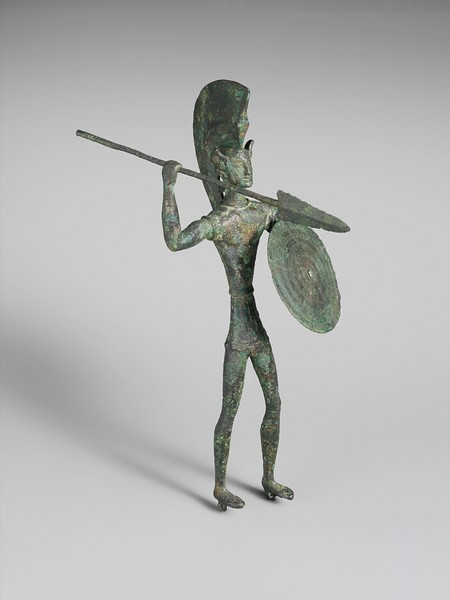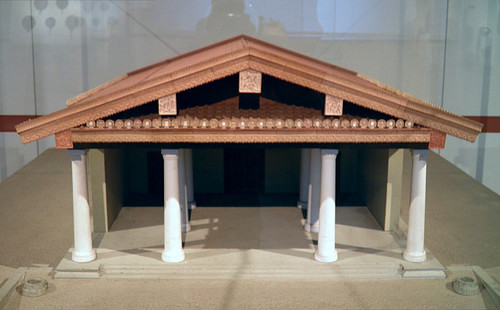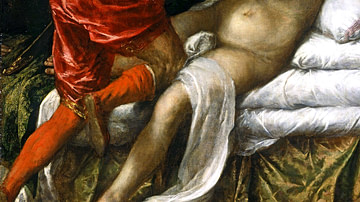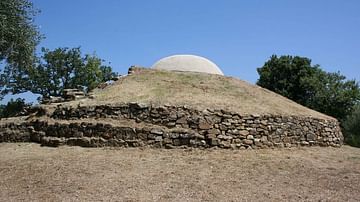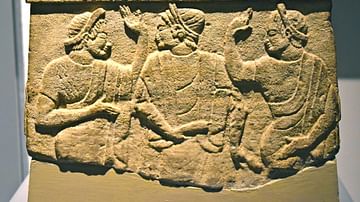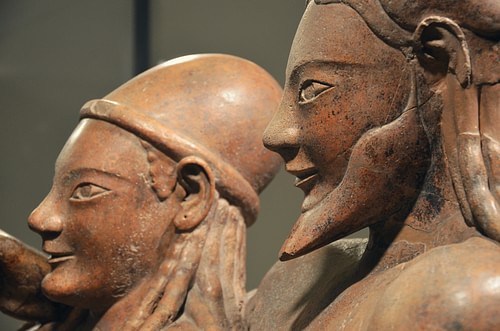
The Etruscan civilization flourished in central Italy between the 8th and 3rd century BCE. The culture was renowned in antiquity for its rich mineral resources and as a major Mediterranean trading power. Much of its culture and even history was either obliterated or assimilated into that of its conqueror, Rome. Nevertheless, surviving Etruscan tombs, their contents and their wall paintings, as well as the Roman adoption of certain Etruscan clothing, religious practices, and architecture, are convincing testament to the great prosperity and significant contribution to Mediterranean culture achieved by Italy's first great civilization.
Villanovan Culture
The Villanovan culture developed during the Iron Age in central Italy from around 1100 BCE. The name is actually misleading as the culture is, in fact, the Etruscans in their early form. There is no evidence of migration or warfare to suggest the two peoples were different. That the Etruscans were indigenous to Italy has been confirmed by DNA studies. The Villanovan culture benefitted from a greater exploitation of the area's natural resources, which allowed villages to form. Houses were typically circular and made of wattle and daub walls and thatch roofs with wooden and terracotta decoration added; pottery models survive which were used to store the ashes of the deceased. With the guarantee of regular, well-managed crops a portion of the community was able to devote itself to manufacturing and trade. The importance of horses is seen in the many finds of bronze horse bits in the large Villanovan cemeteries located just outside their settlements. By around 750 BCE the Villanovan culture had become the Etruscan culture proper, and many of the Villanovan sites would continue to develop as major Etruscan cities. The Etruscans were now ready to establish themselves as one of the most successful population groups in the ancient Mediterranean.
Etruria
The Etruscan cities were independent city-states linked to each other only by a common religion, language, and culture in general. Geographically spread from the Tiber River in the south to parts of the Po Valley in the north, the major Etruscan cities included Cerveteri (Cisra), Chiusi (Clevsin), Populonia (Puplona), Tarquinia (Tarchuna), Veii (Vei), Vetulonia (Vetluna), and Vulci (Velch). Cities developed independently so that innovations in such areas as manufacturing, art and architecture, and government occurred at different times in different places. Generally speaking, coastal sites, with their greater contact with contemporary cultures, evolved quicker but eventually passed on new ideas to the Etrurian hinterland. Nevertheless, the Etruscan cities still developed along their own lines, and significant differences are evident in one city from another.
Prosperity was based on fertile lands and improved agricultural tools to better exploit it; rich local mineral resources, especially iron; the manufacture of metal tools, pottery, and goods in precious materials such as gold and silver; and a trade network which connected the Etruscan cities to each other, to tribes in the north of Italy and across the Alps, and to other maritime trading nations such as the Phoenicians, Greeks, Carthaginians, and the Near East in general. Whilst slaves, raw materials, and manufactured goods (especially Greek pottery) were imported, the Etruscans exported iron, their own indigenous bucchero pottery, and foodstuffs, notably wine, olive oil, grain, and pine nuts.
Historical Overview
With trade flourishing from the 7th century BCE, the cultural impact of the consequent increase in contact between cultures also became more profound. Craftsmen from Greece and the Levant settled in emporia – semi-independent trading ports that sprang up on the Tyrrhenian coast, most famously at Pyrgri, one of the ports of Cerveteri. Eating habits, clothing, the alphabet, and religion are just some of the areas where Greek and Near Eastern peoples would transform Etruscan culture in the so-called 'Orientalising' period.
Etruscan cities teamed with Carthage to successfully defend their trade interests against a Greek naval fleet at the Battle of Alalia (aka Battle of the Sardinian Sea) in 540 BCE. Such was the Etruscan dominance of the seas and maritime trade along the Italian coast that the Greeks repeatedly referred to them as scoundrel pirates. In the 5th century BCE, though, Syracuse was the dominant Mediterranean trading power, and the Sicilian city combined with Cumae to inflict a naval defeat on the Etruscans at the battle at Cumae in 474 BCE. Worse was to come when the Syracusan tyrant Dionysius I decided to attack the Etruscan coast in 384 BCE and destroy many of the Etruscan ports. These factors contributed significantly to the loss of trade and consequent decline of many Etruscan cities seen from the 4th to 3rd century BCE.
Inland, Etruscan warfare seems to have initially followed Greek principles and the use of hoplites – wearing a bronze breastplate, Corinthian helmet, greaves for the legs, and a large circular shield – deployed in the static phalanx formation, but from the 6th century BCE, the greater number of smaller round bronze helmets would suggest a more mobile warfare. Although several chariots have been discovered in Etruscan tombs, it is likely that these were for ceremonial use only. The minting of coinage from the 5th century BCE suggests that mercenaries were used in warfare, as they were in many contemporary cultures. In the same century, many towns built extensive fortification walls with towers and gates. All of these developments point to a new military threat, and it would come from the south where a great empire was about to be built, starting with the conquest of the Etruscans. Rome was on the warpath.
In the 6th century BCE some of Rome's early kings, although legendary, were from Tarquinia, but by the late 4th century BCE Rome was no longer the lesser neighbour of the Etruscans and was beginning to flex its muscles. In addition, the Etruscan cause was not in any way helped by invasions from the north by Celtic tribes from the 5th to 3rd century BCE, even if they would sometimes be their allies against Rome. There would follow some 200 years of intermittent warfare. Peace treaties, alliances, and temporary truces were punctuated by battles and sieges such as Rome's 10-year attack on Veii from 406 BCE and the siege of Chiusi and Battle of Sentinum, both in 295 BCE. Eventually, Rome's professional army, its greater organisational skills, superior manpower and resources, and the crucial lack of political unity amongst the Etruscan cities meant that there could only be one winner. 280 BCE was a significant year and saw the fall of Tarquinia, Orvieto, and Vulci, amongst others. Cerveteri fell in 273 BCE, one of the last to hold out against the relentless spread of what was fast becoming a Roman empire.
The Romans often butchered and sold into slavery the vanquished, established colonies, and repopulated areas with veterans. The end finally came when many Etruscan cities supported Marius in the civil war won by Sulla who promptly sacked them all over again in 83 and 82 BCE. The Etruscans became Romanised, their culture and language giving way to Latin and Latin ways, their literature destroyed, and their history obliterated. It would take 2,500 years and the almost miraculous discovery of intact tombs stuffed with exquisite artefacts and decorated with vibrant wall paintings before the world realised what had been lost.
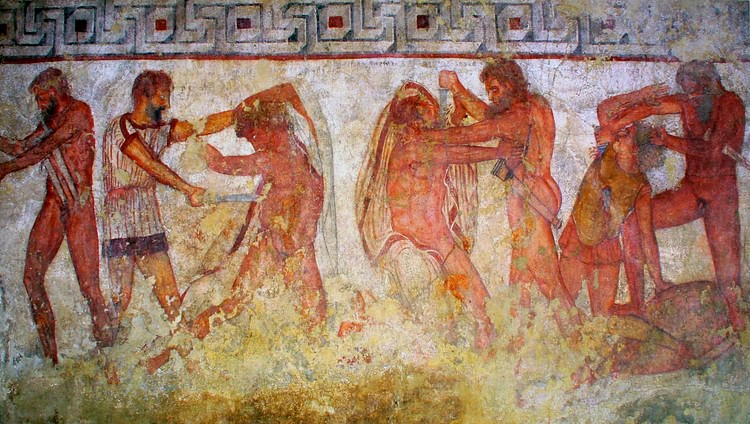
Government & Society
The early government of the Etruscan cities was based on a monarchy but later developed into rule by an oligarchy who supervised and dominated all public positions and a popular assembly of citizens where these existed. The only evidence of a political connection between cities is an annual meeting of the Etruscan League. This is a body we know next to nothing about except that the 12 or 15 of the most important cities sent elders to meet together, largely for religious purposes, at a sanctuary called Fanum Voltumnae whose location is unknown but was probably near Orvieto. There is also ample evidence that Etruscan cities occasionally fought each other and even displaced the populations of lesser sites, no doubt, a consequence of the competition for resources which was driven both by population increases and by a desire to control increasingly lucrative trade routes.
Etruscan society had various levels of social status from foreigners and slaves to women and male citizens. Males of certain clan groups seem to have dominated key roles in the areas of politics, religion and justice and one's membership of a clan was likely more important than even which city one came from. Women enjoyed more freedom than in most other ancient cultures, for example, being able to inherit property in their own right, even if they were still not equal to males and unable to participate in public life beyond social and religious occasions.
Etruscan Religion
The religion of the Etruscans was polytheistic with gods for all those important places, objects, ideas, and events, which were thought to affect or control everyday life. At the head of the pantheon was Tin, although like most such figures he was probably not thought to concern himself much with mundane human affairs. For that, there were all sorts of other gods such as Thanur, the goddess of birth; Aita, god of the Underworld; and Usil, the Sun god. The national Etruscan god seems to have been Veltha (aka Veltune or Voltumna) who was closely associated with vegetation. Lesser figures included winged females known as Vanth, who seem to be messengers of death, and heroes, amongst them Hercules, who was, along with many other Greek gods and heroes, adopted, renamed and tweaked by the Etruscans to sit alongside their own deities.
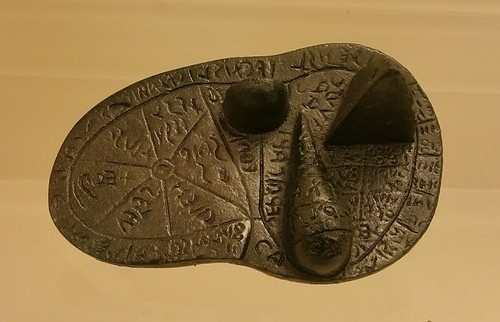
The two main features of the religion were augury (reading omens from birds and weather phenomena like lightning strikes) and haruspicy (examining the entrails of sacrificed animals to divine future events, especially the liver). That the Etruscans were particularly pious and preoccupied with destiny, fate and how to affect it positively was noted by ancient authors such as Livy, who famously described them as "a nation devoted beyond all others to religious rites" (Haynes, 268). Priests would consult a body of (now lost) religious texts called the Etrusca disciplina. The texts were based on knowledge given to the Etruscans by two divinities: the wise infant Tages, grandson of Tin, who miraculously appeared from a field in Tarquinia while it was being ploughed, and the nymph Vegoia (Vecui). The Etrusca disciplina dictated when certain ceremonies should be performed and revealed the meaning of signs and omens.
Such ceremonies as animal sacrifices, the pouring of blood into the ground, and music and dancing usually occurred outside temples built in honour of particular gods. Ordinary folk would leave offerings at these temple sites to thank the gods for a service done or in the hope of receiving one in the near future. Votive offerings were, besides foodstuffs, typically in the form of inscribed pottery vessels and figurines or bronze statuettes of humans and animals. Amulets were worn, especially by children, for the same reason and to keep away evil spirits and bad luck. The presence of both precious and everyday objects in Etruscan tombs is an indicator of a belief in the afterlife which they considered a continuation of the person's life in this world, much like the ancient Egyptians. If the wall paintings in many tombs are an indicator, then the next life, at least for those occupants, started with a family reunion and rolled on to an endless round of pleasant banquets, games, dancing, and music.
Etruscan Architecture
The most ambitious architectural projects of the Etruscans were temples built in a sacred precinct where they could make offerings to their gods. Starting with dried mud-brick buildings using wooden poles and thatch roofs the temples, by c. 600 BCE, had gradually evolved into more solid and imposing structures using stone and Tuscan columns (with a base but no flutes). Each town had three main temples, as dictated by the Etrusca disciplina. Much like Greek temples in design, they differed in that usually only the front porch had columns and this extended further outwards than those designed by Greek architects. Other differences were a higher base platform, a three-room cella inside, a side entrance, and large terracotta roof decorations. These latter were first seen in the buildings of the Villanovan culture but now became much more extravagant and included life-size figure sculpture such as the striding figure of Apollo from the c. 510 BCE Portonaccio Temple at Veii.
Private houses from the early 6th century BCE have multiple intercommunicating rooms, sometimes with a hall and a private courtyard, all on one floor. Roofs are gabled and supported by columns. They had an atrium, an entrance hall open to the sky in the centre and with a shallow basin on the floor in the middle for collecting rainwater. Opposite was a large room, with a hearth and cistern, and side rooms including accommodation for servants.
The burial practices of the Etruscans were by no means uniform across Etruria or even over time. A general preference for cremation eventually gave way to inhumation and then back to cremation again in the Hellenistic period, but some sites were slower to change. It is the burial of members of the same family over several generations in large earth-covered tombs or in small square buildings above ground that are, in fact, the Etruscan's greatest architectural legacy. Some circular tombs measure as much as 40 metres in diameter. They have corbelled or domed ceilings and are often accessed by a stone-lined corridor. The cube-like structures are best seen in the Banditaccia necropolis of Cerveteri. Each has a single doorway entrance, and inside are stone benches on which the deceased were laid, carved altars, and sometimes stone seats were set. Built in orderly rows, the tombs indicate a greater concern with town-planning at that time.
Etruscan Art
Without doubt the greatest artistic legacy of the Etruscans is their magnificent tomb wall paintings which give a unique and technicolour glimpse into their lost world. Only 2% of tombs were painted, which indicates only the elite could afford such luxury. The paintings are applied either directly to the stone wall or onto a thin base layer of plaster wash with the artists first drawing outlines using chalk or charcoal. The use of shading is minimal, but the colour shades many so that the pictures stand out vibrantly. The earliest date to the mid-6th century BCE, but topics remain consistent over the centuries with a particular love of dancing, music, hunting, sports, processions, and dining scenes. Sometimes there are also historical scenes such as the battles depicted in the Francois Tomb at Vulci. The paintings give us not only an idea of Etruscan daily life, eating habits, and clothing but also reveal social attitudes, notably to slaves, foreigners, and women. For example, the presence of married women at banquets and drinking parties (indicated by accompanying inscriptions) shows that they enjoyed a more equal social status with their husbands than seen in other ancient cultures of the period.
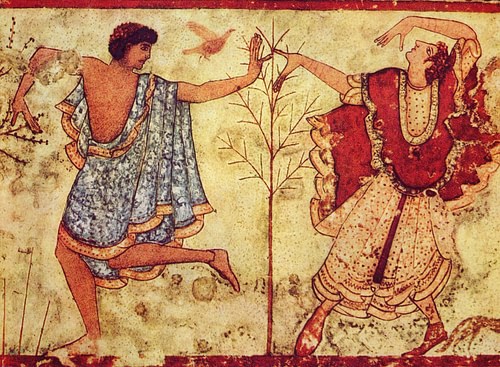
Pottery was another area of expertise. Bucchero is the indigenous pottery of Etruria and has a distinctive, almost black glossy finish. Produced from the early 7th century BCE, the style often imitated embossed bronze vessels. Popular shapes include bowls, jugs, cups, utensils, and anthropomorphic vessels. Bucchero wares were commonly placed in tombs and were exported widely throughout Europe and the Mediterranean. Another later specialisation was the production of terracotta funerary urns which had a half-life-size figure of the deceased on the lid sculpted in the round. These were painted, and although sometimes a little idealised, they, nevertheless, present a realistic portraiture. The sides of these square urns are often decorated with relief sculpture showing scenes from mythology.
Bronze work had been another Etruscan speciality dating back to the Villanovan period. All manner of daily items were made in the material, but the artist's hand is best seen in small statuettes and, particularly, bronze mirrors which were decorated with engraved scenes, again, usually from mythology. Finally, large-scale metal sculpture was produced of exceptional quality. Very few examples have survived, but those that do, notably the Chimera of Arezzo, are testimony to the imagination and skill of the Etruscan artist.
Etruscan Legacy
The Romans not only grabbed what lands and treasures they could from their neighbours but also stole quite a few ideas from the Etruscans. The Romans adopted the Etruscan practice of divination (itself an adaptation of Near Eastern practices) along with other features of Etruscan religion such as rituals for establishing new towns and dividing territories, something they would receive ample practice opportunities for as they expanded their empire. Also, Etruscan soothsayers and diviners became a staple member of elite households and army units, acknowledged as they were as the Mediterranean's experts in such matters.
The Tuscan column, arched gate, private villa with atrium, tombs with niches for multiple funerary urns, and large-scale temples on impressive raised stepped platforms are all Etruscan architectural features the Romans would adopt and adapt. Other cultural influences include the victory procession which would become the Roman triumph and the Etruscan robe in white, purple or with a red border, which would become the Roman toga. Finally, in language, the Etruscans passed on many words to their successors in Italy, and through their alphabet, itself adapted from Greek, they would influence northern European languages with the creation of the Runic script.

